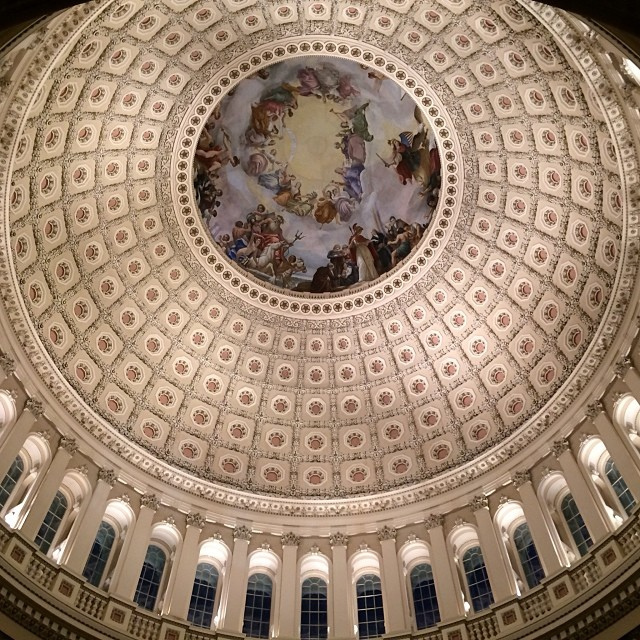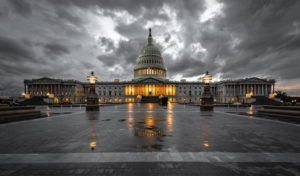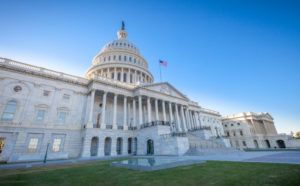
New lookback programs impede public safeguards rather than improve the regulatory system.
The federal regulatory system is in crisis. For the past several decades, a damaging set of mandates has continued to pile up on the books—mandates that threaten to stifle critical progress and undermine the nation’s ability to compete in the world economy. Even today, out-of-touch policymakers are attempting to add still more of these mandates, without regard to their direct, indirect, and cumulative costs to society. One might say that we are facing a tsunami, a flood, or even an avalanche of these mandates.
You’ve heard that sort of rhetoric before, I’m certain, deployed by opponents of various safeguards protecting consumers, workers, the environment, and more. But my diagnosis of the problem refers not to regulatory safeguards that agencies are, after all, obligated to issue as part of their statutory missions, but to the growing number of duplicative and utterly wasteful “lookback” or “retrospective review” requirements that opponents of regulation have sought to erect in their ceaseless bid to block effective implementation and enforcement of landmark protective statutes.
The right wing’s campaign against regulation is really nothing more than an extension of its original opposition to the underlying statutes—the Clean Air Act, Clean Water Act, Occupational Safety and Health Act, food safety legislation, and more. They lost in Congress, but continue the fight in the less public realms of regulation and litigation. They’ve found that while there’s a political cost to be paid for opposing “clean water,” there’s political hay to be made from opposing “regulation” in general. And so they’ve produced a tsunami of proposals to gum up the regulatory works. The push for still more regulatory lookbacks continues to be a favored tactic in this antiregulatory campaign.
Of course, what this campaign ignores is that regulatory lookback programs of all shapes and sizes already abound in our government. The Regulatory Flexibility Act requires agencies to review every rule that has “a significant economic impact upon a substantial number of small entities” within 10 years after the final rule is published. Further, Executive Order 12866 requires agencies to develop a program “under which the agency will periodically review its existing significant regulations to determine whether any such regulations should be modified or eliminated.”
Evidently, the recent push by industry and its allies in Congress to make regulation a dirty word has been so successful that the generally moderate Barack Obama felt compelled to adopt the right wing’s antiregulatory frame and add to the existing morass of regulatory lookback programs. So, in January of 2011, the President issued Executive Order 13563, which builds upon the Executive Order 12866 periodic review program by adding, among other things, time-consuming and resource-intensive procedures for carrying out the lookback program on an ongoing basis.
Some regulatory lookback programs are baked right into the statutes that authorize the regulations. For example, the Clean Air Act directs the U.S. Environmental Protection Agency (EPA) to “complete a thorough review” of the agency’s existing National Ambient Air Quality Standards (NAAQSs) and “to make such revisions…as may be appropriate” at least once every five years.
In many cases, agencies review their existing regulations even when it is not mandated by a particular program—that is, because they independently recognize that such a review is a good idea in certain circumstances. As Michelle Sager, the Director of Strategic Issues at the U.S. Government Accountability Office (GAO), testified before the U.S. Senate Committee on Homeland Security and Governmental Affairs, “Reviews mandated by requirements in statutes or executive orders and related OMB memorandums were sometimes the impetus for reviews, but agencies more often exercised their own discretionary authorities to review regulations.” Significantly, according to Ms. Sager’s testimony, the GAO found that “[a]gencies noted that discretionary reviews generated additional action more often than mandatory reviews, which most often resulted in no changes.”
But industry and its antiregulatory allies in Congress don’t trust agency-led “self-reviews” of existing regulations. They now argue that an independent third party must conduct these reviews and root out any unnecessarily burdensome regulations. They have pushed several bills that would set up different kinds of regulatory lookback programs conducted by a third party. (Of course, antiregulatory members of Congress have not completely given up on mandating new self-reviews. For example, the Regulatory Accountability Act would require all agencies to review all of their “major” rules—generally, those with an annual economic impact of $100 million or more—at least once every 10 years.)
For example, S. 1390—the Regulatory Improvement Act—would create a brand new “Regulatory Improvement Commission” charged with reviewing existing regulations and identifying in a report to Congress regulations that should modified, consolidated, or repealed. The bill would establish expedited legislative procedures requiring Congress to give the recommendations an up-or-down vote. Similarly, the Searching for and Cutting Regulations that are Unnecessarily Burdensome Act—or SCRUB Act—would set up a “Retrospective Regulatory Review Commission” (much like S. 1390’s Regulatory Improvement Commission) that is tasked with reviewing existing regulations to identify those that should be repealed or weakened. For some of those rules, the SCRUB Act would allow them to be immediately repealed or weakened by an act of Congress, similar to S. 1390. Alternatively, the SCRUB Act’s Retrospective Regulatory Review Commission can recommend that a rule be added to a list of rules that are subject to a unique “cut-go” process, under which the issuing agency would be prohibited from issuing any new rule—no matter how small—until the costs of the rule are offset by repealing or weakening an existing rule.
As it happens, several procedures are already in place for third parties to independently evaluate agencies’ existing regulatory programs. For instance, federal law establishes a network of independent Inspectors General for every major executive and independent agency, which, among other things, audits and evaluates the effectiveness of agencies’ regulatory programs. In addition, Congress created the GAO, an independent agency that works to aid Congress’s oversight of the federal government. A key component of the GAO’s work is to audit and evaluate specific regulatory programs in response to requests from members of Congress. As part of this effort, the GAO maintains a “High Risk List,” which it updates at the start of each new Congress in order to bring “attention to agencies and program areas that are high risk due to their vulnerabilities to fraud, waste, abuse, and mismanagement, or are most in need of transformation.” Included on the current list are “Revamping Federal Oversight of Food Safety” and “Transforming EPA’s Process for Assessing and Controlling Toxic Chemicals.”
So, why aren’t all these existing regulatory lookback programs good enough for antiregulatory critics? There is more at work here than antiregulatory members of Congress piling on so they can score political points bashing regulation, writ large. Even lookbacks that identify no regulations to scrap consume valuable resources, waste the time of staff at the various regulatory agencies, and divert the staff at those agencies from the jobs they were hired to do. And that’s exactly the point! Industry and its allies want regulators to be distracted; they want them to fall behind on statutory mandates; they want them to miss court-ordered deadlines. They see delay as profit because such delay gives them more time to produce money-making, if unsafe, products using polluting manufacturing processes. They want to have another few years free of worker-safety regulations that would force them to protect employees from hazards on the job. Delay is victory for them, because by running out the clock they can keep doing what they’re doing, while they work to elect a President more sympathetic to their cause.
If industry and its allies were truly interested in ensuring effective implementation of the law, they would see that existing lookback programs find again and again that the reality of our regulatory system doesn’t match their overblown antiregulatory rhetoric. In many cases, the lookbacks of existing regulations find that they are working exactly as intended. For instance, a 2011 Center for Progressive Reform white paper reviewed 38 regulatory lookbacks conducted by the EPA and the Occupational Safety and Health Administration under the Regulatory Flexibility Act and found that every review concluded that there is a “continued need” for the regulation, meaning that a significant risk to public health, safety, or the environment exists and that the controls called for in the regulation continue to be successful in reducing that risk. In other cases, the lookbacks find that many regulatory safeguards are inadequate and need to be significantly strengthened—not weakened or rescinded. For instance, the GAO included “Transforming EPA’s Process for Assessing and Controlling Toxic Chemicals” on its High Risk List because, according to the GAO, the EPA is failing to effectively implement key chemical assessment programs, including the Integrated Risk Information System (IRIS) program and the Toxic Substances Control Act (TSCA). The GAO has found that without this critical chemical assessment information, the EPA will continue to be unable to protect public health and the environment by limiting exposure to potentially hazardous chemicals.
In short, to the extent that these lookbacks find any systematic problems with the U.S. regulatory system, it is that the regulatory agencies regulate slowly and meekly—in large measure because of industry and right-wing pressure, sometimes coupled with White House timidity. Opponents of regulation disregard these findings because they run directly counter to the antiregulatory narrative they are trying to sell to the American people—one that posits that the United States has accumulated a welter of burdensome and unnecessary regulations and that the agencies responsible are out of control and must be reined in.
We don’t need more lookback programs, such as those outlined in the S. 1390 or the SCRUB Act. If the opponents of regulation want to fight this battle, they should do it honestly, owning up to what they really want: a rewrite or outright repeal of the landmark protective laws that give rise to the regulations they oppose. I’d fight them, but it least it’d be an honest battle.
This essay is part of The Regulatory Review’s five-part series, Debating the Independent Retrospective Review of Regulations.
Pictured in the text is the U.S. Capitol Rotunda. Photo Credit: Architect of the Capitol.




